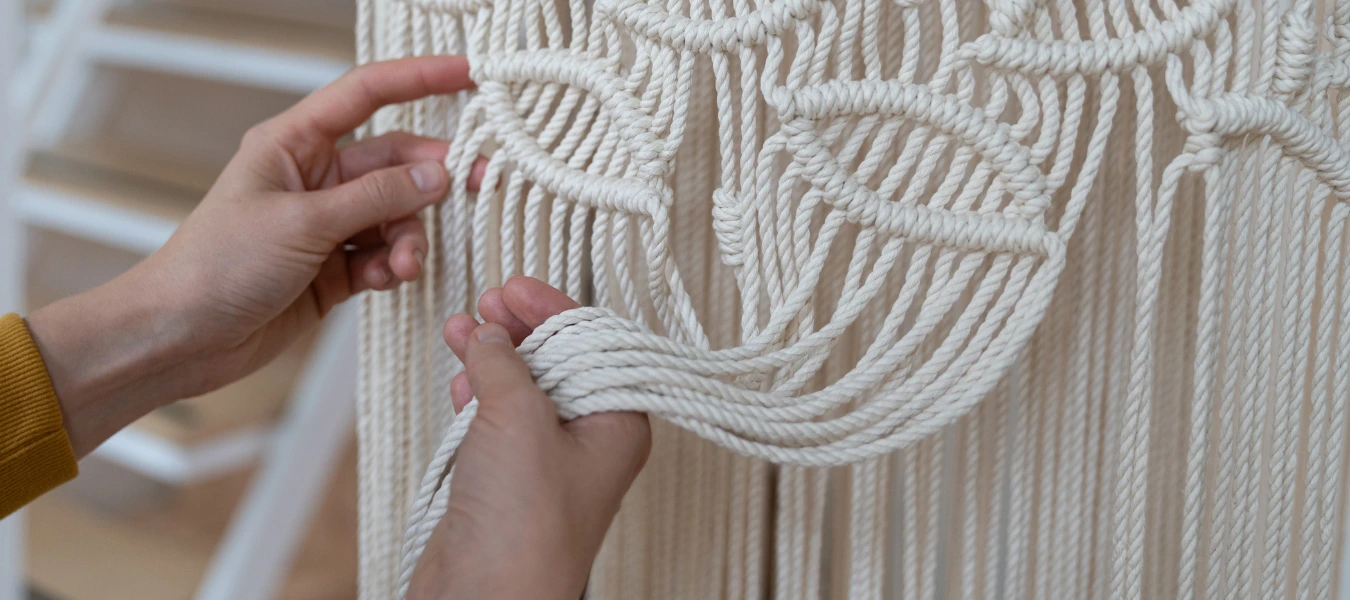Macrame, the art of creating decorative designs through intricate knotting, has captured the attention of crafters worldwide for centuries. Originating in the 13th century with Arabic weavers who used knotting to secure loose ends of woven fabric, macrame evolved as a practical yet artistic textile technique. Today, it’s cherished for its ability to transform simple fibers into beautiful, elaborate pieces like wall hangings, plant holders, jewelry, and more. However, beyond the knots themselves, one crucial element of macrame is the type of yarn used, as it influences both the project’s appearance and functionality.
What is Macrame?
Macrame is a technique that relies solely on various types of knots to create patterns and textures in the finished design. Unlike weaving or knitting, which use interwoven threads and needles, macrame projects are constructed by repeatedly tying specific knots to achieve a structured, often symmetrical design. Some of the basic knots in macrame include the square knot, half hitch, and lark’s head knot. Each type of knot contributes to the overall texture and look of the final piece, allowing for an endless variety of patterns and shapes.
One of the reasons macrame is so popular is its versatility. From delicate necklaces to large wall tapestries, macrame creations come in many forms, making it accessible for crafters of all skill levels. As more people explore this art, they discover that the right type of yarn or cord plays an integral role in the outcome of each project.
Understanding Macrame Yarn
“Macrame yarn” is the specific type of fiber used in macrame projects, often referred to as macrame cord or rope. Typically, macrame yarn is thicker and sturdier than standard yarns, providing greater hold and structure to maintain the intricate patterns formed by knotting. Macrame yarn can come in different materials, thicknesses, and styles, each with unique qualities that impact the look and durability of the finished piece.

Let’s explore some of the most popular types of macrame yarn:
1. “Cotton Yarn”: Cotton is one of the most commonly used materials for macrame, particularly favored by beginners. It is soft, pliable, and easy to handle, making it ideal for learning the various knotting techniques. Cotton macrame yarn also unravels smoothly, allowing for the popular “fringe” effect often seen at the ends of wall hangings and plant holders. Its natural, clean look fits well with modern and minimalist decor.
2. “Jute Yarn“: Jute yarn has a more rustic, natural appearance and a rougher texture compared to cotton. Known for its strength and durability, jute is a popular choice for macrame projects with a bohemian or earthy aesthetic. However, it can be harder on the hands due to its coarse texture, so it may be better suited for those with more experience or for outdoor macrame items where durability is key.
3. “Polyester and Nylon Yarn”: Synthetic macrame yarns like polyester and nylon are ideal for outdoor projects due to their resistance to moisture and wear. These materials are often used for macrame plant hangers or outdoor decorations that need to withstand weather conditions. Additionally, polyester and nylon yarns tend to be more vibrant, allowing for a greater range of color options.
4. “Single-Twist, Three-Ply, and Braided Yarn”: The structure of macrame yarn also varies. Single-twist yarn is soft and fluffy, often used to create a smooth look or fringe details, while three-ply or braided yarn offers more structure and is less prone to unraveling. Each type serves different aesthetic needs, giving artists flexibility in choosing the right material for their specific project.

Choosing the Right Macrame Yarn for Your Project
Selecting the right macrame yarn depends on the style, purpose, and environment of the finished piece. Softer cotton yarns are great for indoor decorations and items where you want a softer, flowy look. In contrast, jute or polyester might be better for functional items like sturdy plant hangers or pieces exposed to outdoor elements. Yarn thickness is also a factor: thinner yarns allow for more detailed work, while thicker yarns are suitable for bold, larger designs.
The Appeal of Macrame Today
The resurgence of macrame in recent years is closely tied to the bohemian design trend and a growing appreciation for handmade crafts. As people seek to personalize their living spaces, macrame offers a unique way to create bespoke decor items with an organic, artisanal touch. Additionally, macrame is accessible to all skill levels, allowing beginners to start with simple projects and gradually build their skills.
In essence, the world of macrame offers endless possibilities, both for seasoned artists and beginners. With the right yarn, patience, and creativity, anyone can create a beautiful, intricate piece of art that adds character and charm to any space. Whether for a calming hobby or a practical project, macrame has proven its enduring appeal in the world of crafts.



















